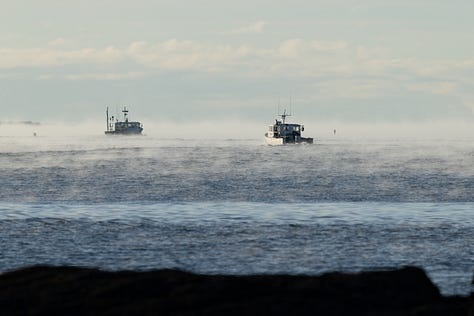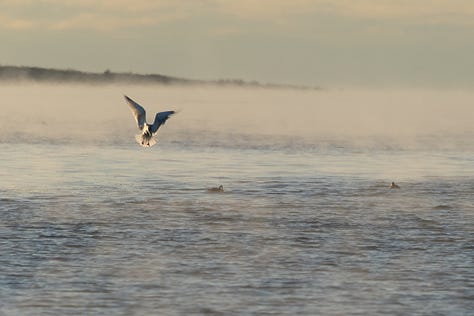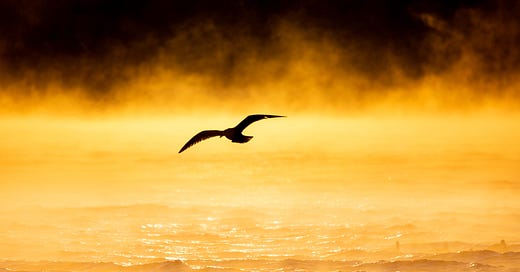For a change, I managed to arrive at the beach before sunrise, drawn by predictions of calm clear skies and an incoming tide. In the summer, I have to be here far earlier to beat the crowds and the parking attendants. Today, the temperature is in the single digits and the lot is deserted.
The marsh grass lining the sandy path glimmered in the predawn light with its frosting of ice crystals. The moon is just past full and the unusually low tide leaves the exposed beach sloping steeply to the still water. The sand was frozen and preserved the fine dendritic tracks left from the trickling outflow of last night’s receding tide.
The smooth water was moving slowly upriver with the tide. Yellows and oranges filled the horizon above the shuttered beach houses. I walked around the curve of the sand and reached my rocky point and its elevated view. The rocks were slick with frozen seaweed and icy mussels and barnacles. I paused to admire the contours and highlights of frost at this intersection of winter air and marine life. The necessary adaptations for extreme tide and temperature fluctuations are remarkable.
There is a stone jetty across the water that defines the channel here. Feeding birds are drawn by the flux of water when the tide change makes fish, crabs, eels and other prey more accessible. Goldeneye ducks, horned grebes, and hulking loons were diving repeatedly just off the beach. I followed the whirring wings of a pair of buffleheads as they rocket past heading upriver.
The intensely cold air over the relatively warmer ocean causes water vapor to form out in the bay, aptly called sea smoke. As the sun crested the horizon, the first rays of light brightened and then gently colored the lovely effervescent mist. I could make out common eider and loons on the water. The eiders intermittently rose up as if standing on the water which made them easy to identify even in the mist. The opportunistic gulls were just silhouettes as they flew from one group of birds to the next in search of food to steal.
Fishing boats periodically move through the channel, the deep throb of diesel engines filling the air. The requisite cold tolerance of the hardy crews is far beyond my capacity. Two boats were surrounded by sea smoke in the bay, one vessel heading out to sea and the other returning to the dock.



I watched in delight as two horned grebes moved closer to the beach. The grebes are smaller and more delicate than the other nearby seabirds. Their red eyes are mesmerizing, framed beautifully within the white face beneath a dark cap. The grebes were alert and turned their heads quickly when on the surface, then gave a graceful leap as they dove. The two birds slowly came towards each other and then swam in tandem for a bit before moving away again.
I was deeply chilled by the end of my visit. My feet stayed warm for a while, then finally cooled to the point of discomfort. Grasping the cold binoculars or camera lens leached out the warmth until I had to put them down and clutch the hand warmers within my gloves. I sat for a while on the slope of the frozen beach on the way out to admire and photograph long-tailed ducks and horned grebes. Groaning as I raised my stiff cold body back to standing, it was clear I was ready to head to the car. I still scanned the water and air as I finished the walk, reluctant as always to leave this beautiful place, my mind full of images of birds, sea smoke and the magic of sunrise.








LOVE the title of your piece and the photos of the gull and the frozen seaweed. Gorgeous. I had a similar experience and will write about it, too. Thanks for the inspiration!
Beautiful essay and photographs--those Bufflehead, and a Horned Grebe is always a treat. Partial to coastal marsh I have spent a lot of time in that landscape in wintertime, you do a wonderful job capturing the feeling, "sea smoke and the magic of sunrise." Thank you.